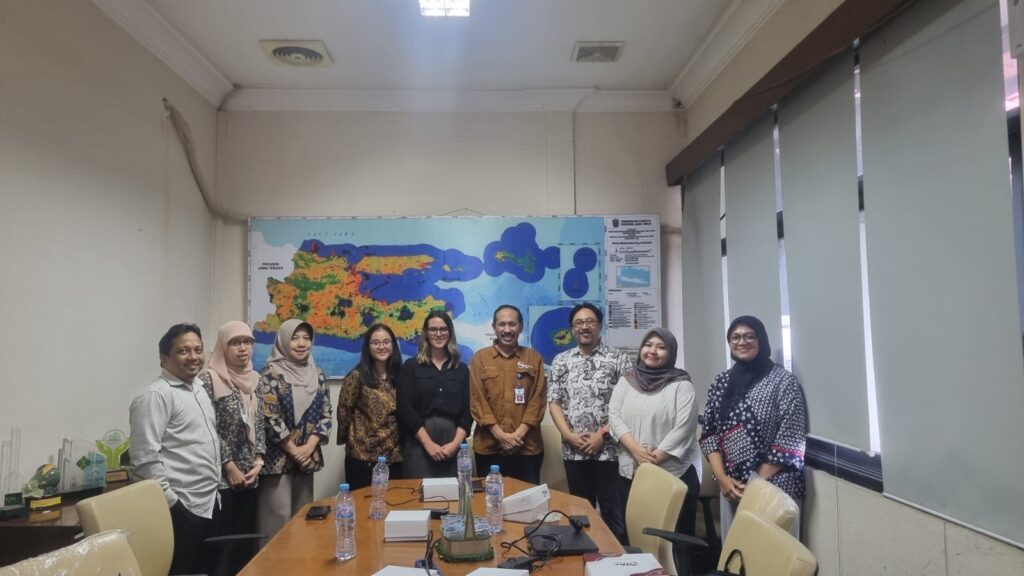- Early engagement with East Java Agency, Bappeda, is critical to securing inter-agency coordination across provincial, municipal, and regency levels in support of transit-oriented development implementation.
- Greater Surabaya is identified as a priority area requiring integrated mass transit solutions due to its urban density and strategic importance in East Java’s mobility system.
- GCIEP is providing technical guidance, reinforcing institutional partnerships, and enabling action planning aligned with inclusive and sustainable development principles.

East Java stakeholders meet to discuss sustainable and inclusive urban mobility for Surabaya.
On 7–8 May 2025, Judith A’bear, from the UK Foreign, Commonwealth and Development Office (FCDO), joined the Green Cities, Infrastructure and Energy Programme (GCIEP) team for a site visit to Surabaya to advance support for transit-oriented development (TOD) in East Java. The two-day engagement began with a strategic coordination meeting with the East Java Provincial Development Planning Agency, Bappeda, followed by targeted discussions with the Provincial Department of Transportation, Trans Jatim, and the Provincial Housing, Settlement and Spatial Planning Agency.
The meeting with Bappeda served as a key opportunity to explore both strategic and technical aspects of the East Java TOD roadmap, particularly within the Gerbangkertosusila (GKS+) area. As the institution responsible for regional planning across the province, Bappeda is instrumental in fostering inter-agency alignment. Engaging Bappeda early ensures a platform for multi-level coordination and enables cross-jurisdictional collaboration between provincial, municipal and regency governments.
Subsequent discussions with the Provincial Department of Transportation focused on the governance and operational frameworks of regional mobility within GKS+. GCIEP reviewed the current performance and structure of Trans Jatim, including its corridor network, integration points and overlaps with transport services provided by local governments and PT KAI. The conversation also introduced the strategic potential of TOD nodes at current transit intersections and terminals—spaces that could evolve into dynamic development anchors.
Engagement with the Spatial Planning Division highlighted the need for clear spatial delineation strategies across five to six regional clusters, with GKS+ identified as the highest-priority area due to its urban density and mobility needs. TOD nodes were discussed as critical tools to bridge the built environment with transport infrastructure—enabling multi-modal integration and promoting better land-use connectivity.
GCIEP’s role is to facilitate shared understanding and provide technical support to East Java’s provincial and local governments in developing TOD action plans. The roadmap emphasises inclusive design principles, removing gender-based barriers to access, and integrating sustainability measures within all TOD interventions.
“Policy alignment across national, provincial and local levels remain a key challenge from the perspective of the Spatial Planning and Utilization Division of the East Java Public Works and Spatial Planning Agency. GCIEP's programme in mapping out the implementation path for transit-oriented areas will help to identify potential nodes to be developed and integrated.” noted Arief Tri Hardjoko, Head of Spatial Planning Division at DPRKPCK of East Java Province.
This visit represents a critical step in aligning policy actors and technical stakeholders around a unified TOD vision. Through sustained dialogue and strengthened institutional collaboration, GCIEP and FCDO are catalysing the strategic support needed to deliver inclusive and sustainable mobility in East Java.
The UK’s Green Cities, Infrastructure and Energy Programme is tackling climate change and extreme poverty by accelerating the delivery of sustainable green cities and climate-resilient infrastructure.
Published
30/05/25
